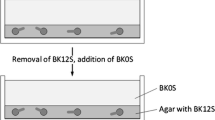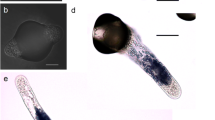Summary
Production of sperm cells by division of the generative cell occurs during growth ofNicotiana (tobacco) pollen tubes through the sporophytic tissue of the style, and is associated with transition to the second phase of pollen-tube growth. WhenNicotiana pollen tubes are grown in liquid culture, the extent of generative-nucleus division and the timing of this division depend on the chemical composition of the medium. Addition of reduced forms of nitrogen, either as mixed amino-acids (0.03% w/v of an acid hydrolysate of casein) or as 1 mM ammonium chloride, induces division of the generative nucleus in over 90% of the tubes; 3 mM calcium nitrate does not stimulate division. Individual amino-acids differ in their ability to induce this division. Contaminants in some batches of poly(ethylene glycol), which is a major component of pollen-tube growth media, inhibit generative-nucleus division; this inhibition is greater in the absence of nitrogen, which increases the observed nitrogen-dependence of division. Reduced forms of nitrogen are also required for growth of pollen tubes after division, when callose plugs are deposited. In the absence of nitrogen, growth continues until the point where sperm cell production would normally occur, then ceases. Addition of amino-acids or ammonium chloride thus allows cultured pollen tubes ofNicotiana to progress to their second phase of growth. WhenNicotiana pollen is germinated in a complete culture medium at 25–26°C, sperm nuclei are first observed in the growing tubes after about 10 h, and by about 16 h most of the tubes have undergone division; at lower temperatures, division is delayed. The timing of division also varies between species ofNicotiana, but division occurs similarly in self-compatible and self-incompatible species. Anaphase in an individual pollen tube is calculated to take less than 4 min. The resultant sperm nuclei usually trail behind the vegetative nucleus, but a variety of arrangements of the three nuclei are observed.
Similar content being viewed by others
Abbreviations
- DAPI:
-
4′,6-diamidino-2-phenylindole
- PEG:
-
poly(ethylene glycol)
- OG:
-
“ordinary grade” of PEG
- SP:
-
“Specially Purified for Biochemistry” grade of PEG
References
Brewbaker JL (1959) Biology of the angiosperm pollen grain. Ind J Genet Plant Breed 19: 121–133
— (1967) The distribution and phylogenetic significance of binucleate and trinucleate pollen grains in the angiosperms. Amer J Bot 54: 1069–1083
—, Majumder SK (1961) Cultural studies of the pollen population effect and the self-incompatibility inhibition. Amer J Bot 48: 457–464
Broothaerts W, Vanvinckenroye P, Decock B, Van Damme J, Vendrig JC (1991)Petunia hybrida S-proteins: ribonuclease activity and the role of their glycan side chains in self-incompatibility. Sex Plant Reprod 4: 258–266
Capkova V, Hrabetova E, Tupy J, Rihova L (1983) Amino-acid uptake and protein synthesis in cultured tobacco pollen. Biochem Physiol Pflanzen 178: 511–520
Cresti M, Ciampolini F, Sarfatti G (1980) Ultrastructural investigations onLycopersicon peruvianum pollen activation and pollen tube organisation after self- and cross-pollination. Planta 150: 211–217
—, Ciampolini F, Tiezzi A (1986) Ultrastructural studies onNicotiana tabacum pollen tubes grown in different culture medium (preliminary results). Acta Bot Neerl 35: 285–292
Evans J, Pressey R, Reger BJ (1987) Amino-acids in stigmas ofPennisetum americanum. Phytochemistry 26: 2661–2663
George EF, Sherrington PD (1984) Plant propagation by tissue culture. Exegetics, Basingstoke, UK
Herrero M, Dickinson HG (1980) Pollen tube growth following compatible and incompatible intraspecific pollinations inPetunia hybrida. Planta 148: 217–221
— (1981) Pollen tube development inPetunia hybrida following compatible and incompatible intraspecific matings. J Cell Sci 47: 365–383
Heslop-Harrison J (1987) Pollen germination and pollen-tube growth. Int Rev Cytol 107: 1–78
Hoekstra FA, Bruinsma J (1979) Protein synthesis of binucleate and trinucleate pollen and its relationship to tube emergence and growth. Planta 146: 559–566
Hoggart RM, Clarke AE (1984) Arabinogalactans are common components of angiosperm styles. Phytochemistry 23: 1571–1573
Jahnen W, Lush WM, Clarke AE (1989) Inhibition of in vitro pollen tube growth by isolatedS-glycoproteins ofNicotiana alata. Plant Cell 1: 501–510
Kahn TL, DeMason DA (1988)Citrus pollen tube development in cross-compatible gynoecia, self-incompatible gynoecia, and in vitro. Can J Bot 66: 2527–2532
Kaul V, Theunis CH, Palser BF, Knox RB, Williams EG (1987) Association of the generative cell and vegetative nucleus in pollen tube ofRhododendron. Ann Bot 59: 227–235
Knox RB (1984) Pollen-pistil interactions. In: Linskens HF, Heslop-Harrison J (eds) Cellular interactions. Springer, Berlin Heidelberg New York Tokyo, pp 508–608 (Pirson A, Zimmermann MH (eds) Encyclopedia of plant physiology, NS, vol 17)
Kroh M, Miki-Hirosige H, Rosen W, Loewus F (1970) Incorporation of label into pollen tube walls from myoinositol-labelledLilium longiflorum pistils. Plant Physiol 45: 92–94
Kyo M, Harada H (1986) Control of the developmental pathway of tobacco pollen in vitro. Planta 168: 427–432
Labarca C, Loewus F (1972) The nutritional role of pistil exudate in pollen tube wall formation inLilium longiflorum. I. Utilization of the injected stigmatic exudate. Plant Physiol 50: 7–14
— — (1973) The nutritional role of pistil exudate in pollen tube wall formation inLilium longiflorum. II. Production and utilization of exudate from stigma and stylar canal. Plant Physiol 52: 87–92
—, Kroh M, Loewus F (1970) The composition of stigmatic exudate fromLilium longiflorum. Labeling studies withmyo-inositol, D-glucose and L-proline. Plant Physiol 46: 150–156
LaFleur GJ, Mascarenhas JP (1978) The dependence of generative cell division inTradescantia pollen tubes on protein and RNA synthesis. Plant Sci Lett 12: 251–255
—, Gross AE, Mascarenhas JP (1981) Optimization of culture conditions for the formation of sperm cells in pollen tubes ofTradescantia. Gamete Res 4: 35–40
Lagerwerff GV, Ogata G, Eagle HE (1961) Control of osmotic pressure of culture solutions with polyethylene glycol. Science 133: 1486–1487
Mascarenhas JP (1975) The biochemistry of angiosperm pollen development. Bot Rev 41: 259–314
Mazia D (1961) Mitosis and the physiology of cell division. In: Brachet J, Mirsky AE (eds) The cell. Biochemistry, physiology, morphology, vol III, meiosis and mitosis. Academic Press, New York, pp 77–412
Mulcahy GB, Mulcahy DL (1982) The two phases of growth ofPetunia hybrida (Hort. Vilm.-Andz.) pollen tubes through compatible styles. J Palynol 18: 61–64
— — (1983) A comparison of pollen tube growth in bi- and trinucleate pollen. In: Mulcahy DL, Ottaviano E (eds) Pollen: biology and implications for plant breeding. Elsevier, Amsterdam, pp 29–33
— — (1988) The effect of supplemented media on the growth in vitro of bi- and tri-nucleate pollen. Plant Sci 55: 213–216
de Nettancourt D (1974) Genetical and ultrastructural aspects of self and cross incompatibility in interspecific hybrids between self-compatibleLycopersicon esculentum and self-incompatibleL. peruvianum. Theor Appl Genet 44: 278–288
Palevitz BA (1990) Kinetochore behaviour during generative cell division inTradescantia virginiana. Protoplasma 157: 120–127
—, Cresti M (1989) Cytoskeletal changes during generative cell division and sperm formation inTradescantia virginiana. Protoplasma 150: 54–71
Read SM, Rasmussen R, Bacic A, Clarke AE (1989) Metabolic analysis of cell wall synthesis in pollen tubes ofNicotiana alata. In: Fry SC, Brett CT, Grant-Reid JS (eds) Fifth Cell Wall Meeting, Edinburgh, UK. Scottish Cell Wall Group, Edinburgh, Abst 147
Rosen WG (1971) Pollen-pistil interaction inLilium. In: Heslop-Harrison J (ed) Pollen: development and physiology. Butterworth, London, pp 239–260
—, Gawlik SR (1966) Relation of lily pollen tube fine structure to pistil compatibility and mode of nutrition. In: Uyeda R (ed) (eds) Electron microscopy 1966, vol II, biology. Proceedings of the Sixth International Congress for Electron Microscopy, Kyoto. Maruzen, Tokyo, pp 313–314
Rougier M, Jnoud N, Said C, Russell S, Dumas C (1991) Male gametophyte development and formation of the male germ unit inPopulus deltoides following compatible pollination. Protoplasma 162: 140–150
Smith CL, Ahkong QF, Fisher D, Lucy JA (1982) Is purified poly(ethylene glycol) able to induce cell fusion? Biochim Biophys Acta 692: 109–114
Steer MW, Steer JM (1989) Pollen tube tip growth. New Phytol 111: 323–358
Tupy J (1961) Investigation of free amino-acids in cross-, self- and non-pollinated pistils ofN. alata. Biol Plant 3: 47–64
—, Rihova L (1984) Changes and growth effect of pH in pollen tube culture. J Plant Physiol 115: 1–10
—, Hrabetova E, Capkova V (1983) Amino acids and bivalent cations in the growth of tobacco pollen in mass culture. Plant Sci Lett 30: 91–98
Van Aelst AC, Van Went JL (1989) Effects of anoxia on pollen tube growth and tube wall formation ofImpatiens glandulifera. Sex Plant Reprod 2: 85–89
Wetherell DF, Dougall DK (1976) Sources of nitrogen supporting growth and embryogenesis in cultured wild carrot tissue. Physiol Plant 37: 97–103
Yu H-S, Hu S-Y, Zhu C (1989) Ultrastructure of sperm cells and the male germ unit in pollen tubes ofNicotiana tabacum. Protoplasma 152: 29–36
- Russell SD (1992) Computer-assisted three-dimensional reconstruction of generative cell mitosis in pollen tubes ofNicotiana. In: Plant reproductive biology: pollen, ovules, and seeds. Proceedings of the XIIth International Congress on Sexual Plant Reproduction, Columbus, Ohio, p 80
Author information
Authors and Affiliations
Rights and permissions
About this article
Cite this article
Read, S.M., Clarke, A.E. & Bacic, A. Requirements for division of the generative nucleus in cultured pollen tubes ofNicotiana . Protoplasma 174, 101–115 (1993). https://doi.org/10.1007/BF01379042
Received:
Accepted:
Issue Date:
DOI: https://doi.org/10.1007/BF01379042




